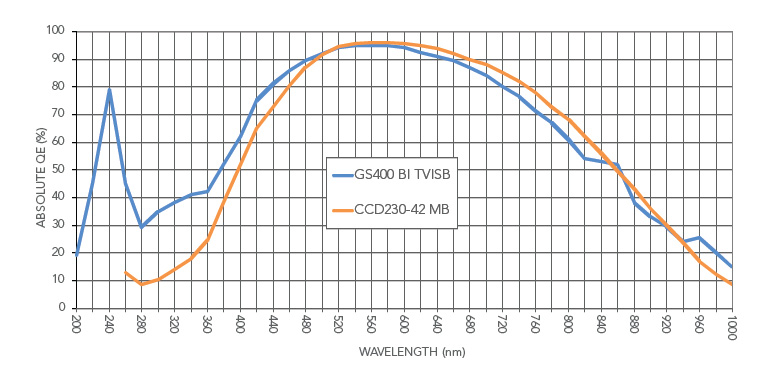Specifications: KL400 vs. PL23042
| KL400 | PL23042 | |
| Sensor Type | Back Illuminated CMOS | Back Illuminated CCD |
| Active Pixels | 2048 x 2048 | |
| Pixel Size | 11 x 11 microns | 15 x 15 microns |
| Effective Area | 22.5 x 22.5 mm | 30.7 x 30.7 mm |
| Sensor Diagonal | 31.9 mm | 43.4 mm |
| Full Well Capacity | 90000 electrons | 150000 electrons |
| Frame Rate (rolling) | 24 fps HDR | 5 seconds per frame |
| Read Noise (Rolling) | 1.6 e- HDR (800 MHz) | 13.5 e- (500 kHz) |
| Dynamic Range | 86 dB HDR | 81 dB (500 kHz) |
| Peak QE | 95% (TVISB) | 93% (Midband) |
| Cooling | Air (Optional Liquid) | |
| Dark Current | 0.6 eps at -20C | 0.2 eps at -30C |
| Interface | USB 3.0 (Optional QSFP) | USB 2.0 |
| Data Bit Depth | 16 bit | |
| Optional Mount | F-mount | |
| Subarray Readout | Yes | |
| Electromechanical Shutter | Optional 45mm | Standard 65mm |
| External Trigger In/Out | Yes | |
| Software | FLI Pilot | FLIGrab |
| SDK | USB 2 (Open Source) | Kepler (Open Source) |
ProLine and MicroLine cameras using the e2v CCD230-42 have been a standard for astronomy research since their release in 2012. The Kepler KL400 with back-illuminated CMOS provides an alternative with a higher signal-to-noise ratio (SNR) for exposures less than 7 minutes, as well as the potential for much higher frame rates.
The table below is a comparison of the ProLine PL23042 and the Kepler KL400 cameras, using a low flux value of 1 photon/pixel/second.
| Exposure (sec) | 400 SNR | 23042 SNR |
| 1 x 900 | 21.6 | 23.4 |
| 10 x 90 | 21.4 | 15.4 |
| 1 x 420 | 14.8 | 14.8 |
| 10 x 42 | 14.5 | 8.0 |
Summary: A Paradigm Shift
It is no surprise that the CCD’s best performance is with a single long exposure. At 15 minutes, the PL23042 has a somewhat higher SNR than the KL400. What may be surprising is how little the Kepler KL400’s signal-to-noise ratio changes when multiple images are stacked.
The benefit of taking multiple short exposures is the option to discard a bad exposure ruined by satellite trails, tracking errors, or bad seeing (etc.). Incredible low-noise images are now possible with a single long exposure or many stacked short exposures. The KL400’s low noise allows it to be used for a wide range of applications and requirements.
Quantum Efficiency: CCD230-42 versus GSense400 TVISB

